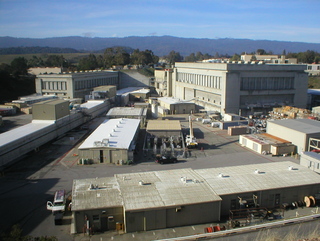« Comments Enabled | Home | New Laptop Time »
December 20, 2009
Trip to Stanford
On Friday I got back to Hamburg from San Francisco, where I'd been taking part in experiments at the Stanford Linear Accelerator Cente. We used the LCLS to zap various kinds of object and measure the resulting signals. Without going into too many gory details, I'm happy to be able to say that the experiment was a great success and we got several terabytes of useful data, which we'll be analysing for many months to come.
I hardly had any time to escape the campus or to explore, but I did manage to find some sites of geeky interest. Here's a photo of the research stations at the end of the two mile long linear accelerator, which is hidden by the trees at the back of the picture. The large concrete building on the right is End Station A, where the first experimental evidence for the existence of quarks was recorded around 1966. Their experiment was like a much larger version of Rutherford's scattering experiment with alpha particles and gold foil. Today, End Station A contains test experiments to prepare for the International Linear Collider. I wasn't able to go inside - it's probably possible, subject to the particle accelerator's beam being directed elsewhere and talking to the right people, but there wasn't time and I wasn't keen to push the limits of my security pass (I also couldn't find the door..).
 The similar concrete monstrosity on the left is End Station B, which probably contains similarly cool things (remember what I wrote about concrete?). The long building which comes out between and runs off the picture to the left is the LCLS beam transport hall. Standing where I took this picture, below me and to the left would be the undulator hall, which contains magnets which cause the electron beam to emit X-ray pulses of unimaginable brightness and brevity. The tunnel emerges on the other side of the hill I'm standing on, where the electrons and X-rays move into the building where we worked. The electron beam is dumped (basically by directing it into the ground) and the X-rays make their way into our experiment.
The similar concrete monstrosity on the left is End Station B, which probably contains similarly cool things (remember what I wrote about concrete?). The long building which comes out between and runs off the picture to the left is the LCLS beam transport hall. Standing where I took this picture, below me and to the left would be the undulator hall, which contains magnets which cause the electron beam to emit X-ray pulses of unimaginable brightness and brevity. The tunnel emerges on the other side of the hill I'm standing on, where the electrons and X-rays move into the building where we worked. The electron beam is dumped (basically by directing it into the ground) and the X-rays make their way into our experiment.
I hardly had any time to escape the campus or to explore, but I did manage to find some sites of geeky interest. Here's a photo of the research stations at the end of the two mile long linear accelerator, which is hidden by the trees at the back of the picture. The large concrete building on the right is End Station A, where the first experimental evidence for the existence of quarks was recorded around 1966. Their experiment was like a much larger version of Rutherford's scattering experiment with alpha particles and gold foil. Today, End Station A contains test experiments to prepare for the International Linear Collider. I wasn't able to go inside - it's probably possible, subject to the particle accelerator's beam being directed elsewhere and talking to the right people, but there wasn't time and I wasn't keen to push the limits of my security pass (I also couldn't find the door..).
 The similar concrete monstrosity on the left is End Station B, which probably contains similarly cool things (remember what I wrote about concrete?). The long building which comes out between and runs off the picture to the left is the LCLS beam transport hall. Standing where I took this picture, below me and to the left would be the undulator hall, which contains magnets which cause the electron beam to emit X-ray pulses of unimaginable brightness and brevity. The tunnel emerges on the other side of the hill I'm standing on, where the electrons and X-rays move into the building where we worked. The electron beam is dumped (basically by directing it into the ground) and the X-rays make their way into our experiment.
The similar concrete monstrosity on the left is End Station B, which probably contains similarly cool things (remember what I wrote about concrete?). The long building which comes out between and runs off the picture to the left is the LCLS beam transport hall. Standing where I took this picture, below me and to the left would be the undulator hall, which contains magnets which cause the electron beam to emit X-ray pulses of unimaginable brightness and brevity. The tunnel emerges on the other side of the hill I'm standing on, where the electrons and X-rays move into the building where we worked. The electron beam is dumped (basically by directing it into the ground) and the X-rays make their way into our experiment.
Leave a comment